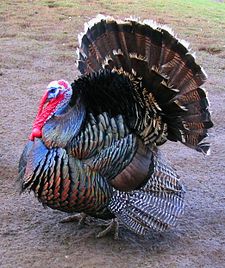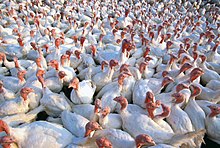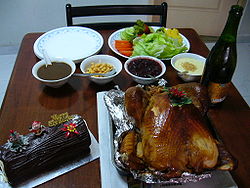Domestic turkey: Difference between revisions
| Line 120: | Line 120: | ||
* [http://www.WhenWillMyTurkeyBeDone.com WhenWillMyTurkeyBeDone.com] Estimates time to roast turkeys and other meats based on measured progress. |
* [http://www.WhenWillMyTurkeyBeDone.com WhenWillMyTurkeyBeDone.com] Estimates time to roast turkeys and other meats based on measured progress. |
||
* [http://www.montrealgazette.com/news/canada/researchers+carve+into+today+turkeys+through+tracking/2514565/story.html B.C. researchers carve into today's turkeys through DNA tracking ] |
* [http://www.montrealgazette.com/news/canada/researchers+carve+into+today+turkeys+through+tracking/2514565/story.html B.C. researchers carve into today's turkeys through DNA tracking ] |
||
* [http://www.sfu.ca/pamr/media_releases/media_releases_archives/media_02021001.html Study traces roots of turkey taming ] from Simon Fraser University, Canada. |
|||
{{Thanksgiving}} |
{{Thanksgiving}} |
||
Revision as of 16:35, 4 February 2010
| Domesticated turkey | |
|---|---|

| |
| A Broad Breasted Bronze tom displaying | |
Domesticated
| |
| Scientific classification | |
| Kingdom: | |
| Phylum: | |
| Class: | |
| Order: | |
| Family: | |
| Genus: | Meleagris
|
| Species: | M. gallopavo
|
| Binomial name | |
| Meleagris gallopavo (Linnaeus, 1758)
| |
The domesticated turkey is a large poultry bird. The modern domesticated turkey descends from the wild turkey (Meleagris gallopavo), one of the two species of turkey (genus Meleagris); in the past the ocellated turkey (Meleagris ocellata) was also domesticated.
The turkey is raised throughout temperate parts of the world and is a popular form of poultry, partially because industrialized farming has made it very cheap for the amount of meat it produces. The female domesticated turkey is referred to as a hen and the chick as a poult. In the United States, the male is referred to as a tom, while in Europe, the male is a stag. The average lifespan for a domesticated turkey is ten years.
The great majority of domesticated turkeys are bred to have white feathers because their pin feathers are less visible when the carcass is dressed, although brown or bronze-feathered varieties are also raised. The fleshy protuberance atop the beak is the snood and the one attached to the underside of the beak is known as a wattle.
Despite the name, turkeys have no direct relation to the country of Turkey and are native to North America; see further under Turkey (bird): History and naming.
History

The modern domesticated turkey is descended from one of six subspecies of Wild Turkey, Meleagris gallopavo gallopavo,[1] ancient Mesoamericans having chosen to domesticate this taxon. The Aztecs domesticated the turkey (Mexican Spanish guajolote, from Nahuatl huexolotl) and used it as a major source of protein (meat and eggs), and also employed its feathers extensively for decorative purposes, as did many other Mesoamerican cultures. The turkey was associated with their trickster god Tezcatlipoca,[2] perhaps because of its humorous behavior.There is also evidence that it is possible the Hopi Indians may have domesticated the turkey even before the Aztecs.
Turkeys were taken to Europe by the Spanish, who had found them as a favorite domesticated animal among the Aztecs and other Mesoamerican peoples. After being introduced to Europe, many distinct turkey breeds were developed (e.g. Spanish Black, Royal Palm). In the early 20th century, many advances were made in the breeding of turkeys, resulting in varieties such as the Beltsville Small White.
Availability and commercial production

Prior to World War II, turkey was something of a luxury in the United Kingdom, with goose or beef a more common Christmas dinner (In Charles Dickens' A Christmas Carol, Bob Cratchit had a goose before Scrooge bought him a turkey).
Turkey production in the United Kingdom was centered in East Anglia, using two breeds, the Norfolk Black and the Norfolk Bronze (also known as Cambridge Bronze). These would be driven as flocks, after shoeing, down to markets in London from the 17th century onwards - the breeds having arrived in the early 16th century via Spain (1500).[3]
Intensive farming of turkeys from the late 1940s dramatically cut the price, and it became the most common Christmas dinner meat. With the availability of refrigeration, whole turkeys could be shipped frozen to distant markets. Later advances in disease control increased production even more. Advances in shipping, changing consumer preferences and the proliferation of commercial poultry plants has made fresh turkey inexpensive as well as readily available.
In commercial production, breeder farms supply eggs to hatcheries. After 28 days, the hatched poults are sexed and delivered to the grow-out farms; hens are raised separately from toms because of different growth rates. Rations generally include corn and soybean meal, with added vitamins and minerals, and is adjusted for protein, carbohydrate and fat based on the age and nutrient requirements. Hens are killed (or harvested as turkey breeders say) at about 14 weeks and toms at about 18 weeks.
The dominant commercial breed is the Broad-breasted Whites (similar to "White Holland", but a separate breed), which have been selected for size and amount of meat. Mature toms are too large to achieve natural fertilization without injuring the hens, so their semen is collected, and hens are inseminated artificially. Several hens can be inseminated from each collection, so fewer toms are needed. Breeders' meat is too tough for roasting, and is mostly used to make processed meats.
In the UK Bernard Matthews is a large producer of turkeys. Cargill, Butterball and Jennie-O (Hormel) are large producers in the US.
Waste products
Approximately two to four billion pounds of poultry feathers are produced every year by the poultry industry. Most are ground into a protein source for ruminant animal feed, as the protein (keratin) is undigestible for monogastrics. Researchers at the United States Department of Agriculture (USDA) have patented a method of removing the stiff quill from the fibers which make up the feather. As this is a potential supply of natural fibers, research has been conducted at Philadelphia University's School of Engineering and Textiles to determine textile applications for feather fibers. Turkey feather fibers have been blended with nylon and spun into yarn, and then used for knitting. The yarns were tested for strength while the fabrics were evaluated as insulation materials. In the case of the yarns, as the percentage of turkey feather fibers increased, the strength decreased. In fabric form, as the percentage of turkey feather fibers increased, the heat retention capability of the fabric increased.[citation needed]
Intelligence
Turkeys are popularly believed to be unintelligent, with claims made that during a rain storm turkeys will look up until they drown. Despite this image, the turkey is no more or less intelligent than a comparable animal,[4] and while the birds will look at the sky for up to a minute during a rain storm, this is due to a genetic nervous disorder known as tetanic torticollar spasms.[4] Other jests include that it is clumsy and too stupid to realize it can't fly, but both traits are due to modern breeding that makes turkeys much heavier than their wild relatives.[4]
Turkey breeds
- The Broad-breasted White is the commercial turkey of choice for large scale industrial turkey farms, and consequently is the most consumed variety of the bird. Usually the turkey to receive a "presidential pardon", a US custom, is a Broad breasted White.
- The Broad-breasted Bronze is another commercially developed strain of table bird.
- The Standard Bronze looks much like the broad-breasted, except that it is single breasted, and can naturally breed.
- The Bourbon Red turkey is a smaller non-commercial breed with dark reddish feathers with white markings.
- Slate, or Blue Slate, turkeys are a very rare breed with beautiful gray-blue feathers.
- The Black ("Spanish Black", "Norfolk Black") has very dark plumage with a green sheen.
- The Narragansett Turkey is a popular heritage breed named after Narraganset Bay in New England.
- The Chocolate is a rarer heritage breed with markings similar to a Black Spanish, but light brown instead of black in color. Common in the Southern U.S. and France before the Civil War.
- The Beltsville Small White is a small heritage breed, which development started in 1934. The breed was introduced in 1941 and was admitted to the APA Standard in 1951. Although slightly bigger and broader than the Midget White, both are often mislabeled.
- The Midget White is a smaller heritage breed, developed in Massachusetts in the 1950s, sometimes called Beltsville Whites.
Turkeys as food
| Nutritional value per 100 g (3.5 oz) | |
|---|---|
| Energy | 436 kJ (104 kcal) |
4.21 g | |
| Sugars | 3.51 g |
| Dietary fiber | 0.5 g |
1.66 g | |
17.07 g | |
| Vitamins | Quantity %DV† |
| Thiamine (B1) | 11% 0.130 mg |
| Riboflavin (B2) | 25% 0.320 mg |
| Niacin (B3) | 1% 0.110 mg |
| Pantothenic acid (B5) | 3% 0.166 mg |
| Vitamin B6 | 8% 0.128 mg |
| Folate (B9) | 1% 4 μg |
| Vitamin C | 6% 5.7 mg |
| Minerals | Quantity %DV† |
| Calcium | 1% 8 mg |
| Iron | 8% 1.44 mg |
| Magnesium | 5% 21 mg |
| Phosphorus | 13% 162 mg |
| Potassium | 10% 302 mg |
| Zinc | 12% 1.33 mg |
| †Percentages estimated using US recommendations for adults,[5] except for potassium, which is estimated based on expert recommendation from the National Academies.[6] | |
Turkeys are traditionally eaten as the main course of Christmas feasts in much of the world (stuffed turkey) , as well as Thanksgiving in the United States and Canada, though this tradition has its origins in modern times, rather than colonial as is often supposed. Before the 20th century, pork ribs were the most common food on the holiday, as the animals were usually slaughtered in November. Turkeys were once so abundant in the wild that they were eaten throughout the year, the food considered commonplace, whereas pork ribs were rarely available outside of the Thanksgiving-New Year season.[7] It has also displaced, to a certain extent, the traditional Christmas roast goose or beef of the United Kingdom and Europe. While eating turkey was once mainly restricted to special occasions such as these, turkey is now eaten year-round and forms a regular part of many diets.
Turkeys are sold sliced and ground, as well as "whole" in a manner similar to chicken with the head, feet, and feathers removed. Frozen whole turkeys remain popular. Sliced turkey is frequently used as a sandwich meat or served as cold cuts; in some cases where recipes call for chicken it can be used as a substitute. Ground turkey is sold just as ground beef, and is frequently marketed as a healthy beef substitute. Without careful preparation, cooked turkey is usually considered to end up less moist than other poultry meats such as chicken or duck. Leftovers from roast turkey are generally served as cold cuts on Boxing Day in Canada.

Wild turkeys, while technically the same species as domesticated turkeys, have a very different taste from farm-raised turkeys. Almost all of the meat is "dark" (even the breast) with a more intense flavor. The flavor can also vary seasonally with changes in available forage, often leaving wild turkey meat with a gamier flavor in late summer due to the greater number of insects in its diet over the preceding months. Wild turkey that has fed predominantly on grass and grain has a milder flavor. Older heritage breeds also differ in flavor.[citation needed]
A large amount of turkey meat is processed. It can be smoked and as such is sometimes sold as turkey ham. Twisted helices of deep fried turkey meat, sold as "turkey twizzlers," came to prominence in the UK in 2004 when chef Jamie Oliver campaigned to have them and similar foods removed from school dinners.
In the UK in 2009, 7,734,000 Turkeys were consumed on Christmas Day. (stat from Oak House).
Cooking
Both fresh and frozen turkeys are used for cooking; as with most foods, fresh turkeys are generally preferred, although they cost more. Around holiday seasons, high demand for fresh turkeys often makes them difficult to purchase without ordering in advance. For the frozen variety, the large size of the turkeys typically used for consumption makes defrosting them a major endeavor: a typically-sized turkey will take several days to properly defrost.
Turkeys are usually baked or roasted in an oven for several hours, often while the cook prepares the remainder of the meal. Sometimes, a turkey is brined before roasting to enhance flavor and moisture content. This is necessary because the dark meat requires a higher temperature to denature all of the myoglobin pigment than the white meat(very low in myoglobin), so that fully cooking the dark meat tends to dry out the breast. Brining makes it possible to fully cook the dark meat without drying the breast meat. Turkeys are sometimes decorated with turkey frills prior to serving.
In some areas, particularly the American South, they may also be deep fried in hot oil (often peanut oil) for 30 to 45 minutes by using a turkey fryer. Deep frying turkey has become something of a fad, with hazardous consequences for those unprepared to safely handle the large quantities of hot oil required.[8]
Nutritional value
The white meat of turkey is generally considered healthier than dark meat because of its lower fat content, but the nutritional differences are small. And although turkey is reputed to cause sleepiness, holiday dinners are commonly large meals served with carbohydrates, fats, and alcohol in a relaxed atmosphere, all of which are bigger contributors to post-meal sleepiness than the tryptophan in turkey.[9][10]
Accompaniments

When eaten at Christmas in the United Kingdom, turkey is traditionally served with winter vegetables including roast potatoes, Brussels sprouts and parsnips. Cranberry sauce is the traditional condiment in the northern rural areas of the United Kingdom where wild cranberries grow. In the south and in urban areas, where cranberries until recently were difficult to obtain, bread sauce was used in its place, but the availability of commercial cranberry sauce has seen a rise in its popularity in these areas too. Sometimes sausage meat, cocktail sausages or liver wrapped in bacon is also served (known as bacon rolls or "pigs in blankets").
Especially during holiday seasons, stuffing, also known as dressing, is traditionally served with turkey. There are many varieties: oatmeal, chestnut, sage and onion (flavored bread), cornbread, and sausage are the most traditional. Stuffing may either be used to stuff the turkey (as the name implies), or may be cooked separately and served as a side dish.
For Thanksgiving in the United States and Canada, turkey is typically served stuffed or with dressing (on the side), with cranberry sauce and gravy. Common complementary dishes include mashed potatoes, corn, green beans, squash, and sweet potatoes. Pie is the usual dessert, pumpkin being most traditional, apple or pecan also being popular.
Turkey is sometimes used as a substitute for other meats for foods like turkey bacon and turkey hot dogs.
Turkey litter for fuel
Although most commonly used as fertilizer, Turkey litter (droppings mixed with bedding material, usually wood chips) is being used as a fuel source in electric power plants. One such plant in western Minnesota provides 55 megawatts of power using 500,000 tons of dung per year. The plant began operating in 2007.[11]
See also
- List of names for the Wild Turkey
- National Turkey Federation
- American Poultry Association
- Turkey bowling
Footnotes
- ^ C. Michael Hogan. 2008. Wild turkey: Meleagris gallopavo, GlobalTwitcher.com, ed. N. Stromberg
- ^ "Ancient North & Central American History of the Wild Turkey". Wildturkeyzone.com. Retrieved 2007-12-21.
- ^ "The Turkey Club UK". 2007-03-19. Retrieved 2007-12-21.
- ^ a b c Rost, Bob (2003-11-19). "OSU animal scientist debunks dumb turkey myth". Oregon State University Extension News Service. Retrieved 2007-12-21.
- ^ United States Food and Drug Administration (2024). "Daily Value on the Nutrition and Supplement Facts Labels". Retrieved 2024-03-28.
- ^ National Academies of Sciences, Engineering, and Medicine; Health and Medicine Division; Food and Nutrition Board; Committee to Review the Dietary Reference Intakes for Sodium and Potassium (2019). Oria, Maria; Harrison, Meghan; Stallings, Virginia A. (eds.). Dietary Reference Intakes for Sodium and Potassium. The National Academies Collection: Reports funded by National Institutes of Health. Washington, DC: National Academies Press (US). ISBN 978-0-309-48834-1. PMID 30844154.
- ^ Parris, John (1982). Mountain Cooking. Asheville Citizen-Times. ASIN B000UIRZVE.
- ^ "Product Safety Tips: Turkey Fryers". Underwriters Laboratories. Retrieved 2007-12-21.
- ^ "Does eating turkey make you sleepy?". About.com. Retrieved May 11, 2005.
{{cite web}}: Unknown parameter|dateformat=ignored (help) - ^ "Researcher talks turkey on Thanksgiving dinner droop". Massachusetts Institute of Technology News Office. Retrieved November 21, 2006.
{{cite web}}: Unknown parameter|dateformat=ignored (help) - ^ "Turkey-Manure Power Plant Raises Stink with Environmentalists". International Herald Tribune iht.com. Retrieved November 15, 2007.
{{cite web}}: Unknown parameter|dateformat=ignored (help)
External links
- Turkey Recipes, Preparation and Cooking Tips from EatTurkey.com
- How to cook the perfect turkey.
- stuffed Christmas turkey.
- More information on turkeys from Cornell
- Breeds of turkey from Feathersite.com
- WhenWillMyTurkeyBeDone.com Estimates time to roast turkeys and other meats based on measured progress.
- B.C. researchers carve into today's turkeys through DNA tracking
- Study traces roots of turkey taming from Simon Fraser University, Canada.
